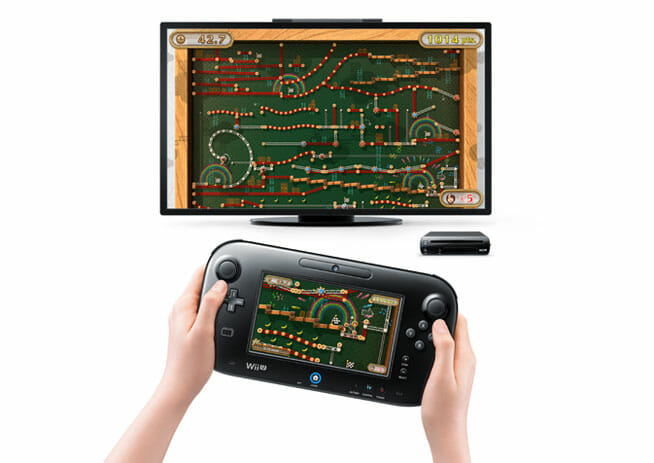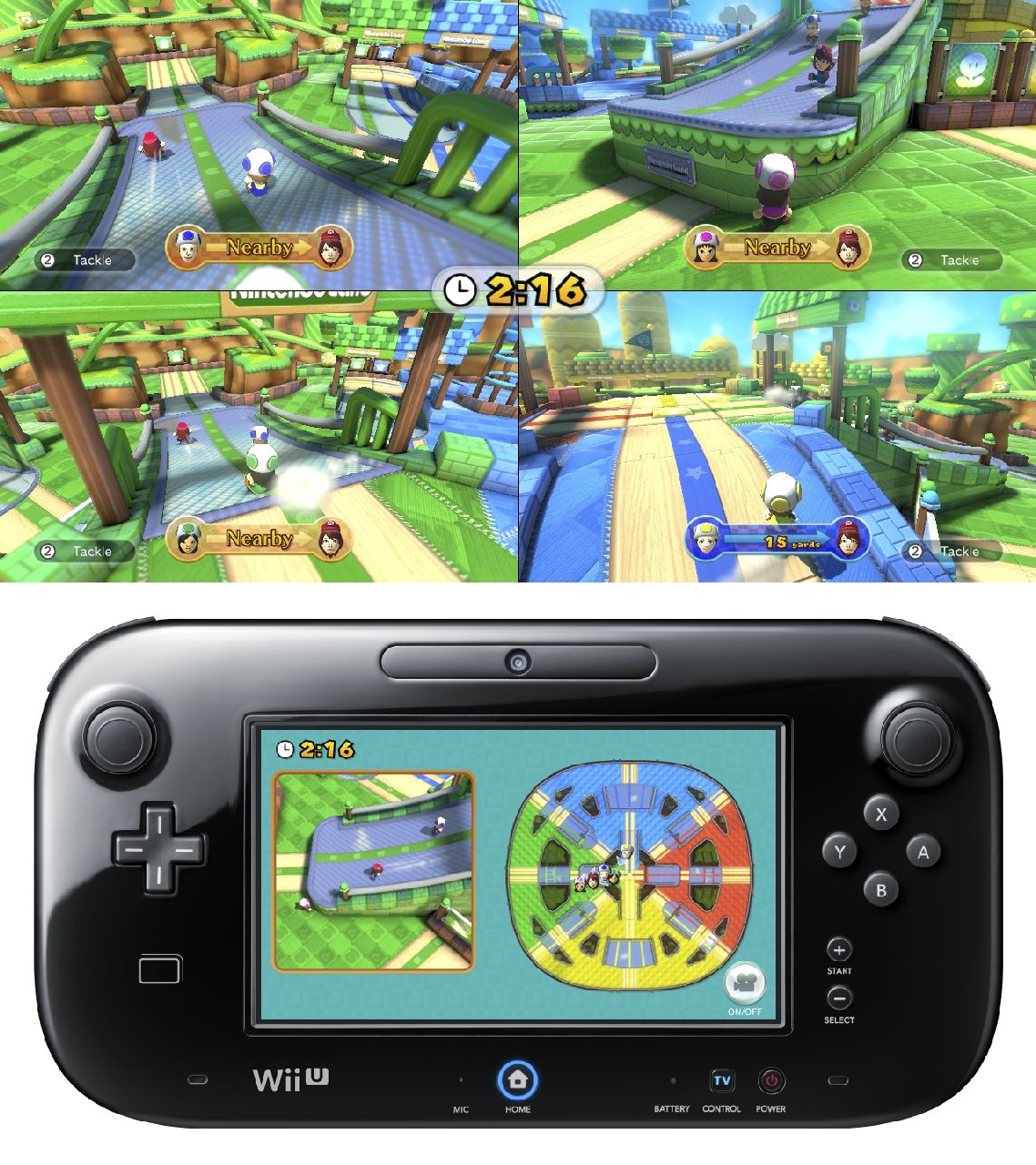
LegoLand exists. It’s a popular attraction. They ripped out the food court of a local mall to install a micro-sized one here in Atlanta. And Legos are just about building things. Lego doesn’t have characters or stories to ride some kind of a vehicle through, like Disney Land. If LegoLand can thrive in the real world then there’s no reason to think a Nintendo Land couldn’t.
But this isn’t real life. This is just a game. Nintendo Land is the pack-in software with the Wii U Deluxe Bundle, and like Wii Sports its goal is to introduce players to the new controller at the heart of the system. That new controller, which is officially called the GamePad, is a handheld touch-screen tablet with dual joysticks, face buttons, and shoulder bumpers and triggers. It’s an iPad Mini squeezed into the middle of a standard videogame controller. It might sound weird or clunky, but you get used to it. Helping you get used to it is why Nintendo Land exists.
Nintendo Land features twelve minigames (per the amusement park theme, the game calls them “attractions”) based on a number of Nintendo properties. Beyond the obvious Mario, Zelda and Metroid appearances, there are appropriations of such obscurities as Game & Watch Octupus and Nazo no Murasame J?, an NES game that only came out in Japan. Some are for individual players only, while half of them allow co-op or competitive multiplayer with additional players using some combination of the old Wii Remote, Nunchuk and Wii MotionPlus troika. Collectively Nintendo Land’s roster shows off a variety of in-game uses for the GamePad.
The best game here is Donkey Kong’s Crash Course. If this was released for the iPhone it would be hailed as one of the best mobile games of the year. It’s a physics-intensive puzzler where you tilt the GamePad to navigate a cart through an elaborate maze of steel girders. The more you angle the GamePad the faster the cart goes in that direction. You have to keep the cart steady, though, as you’ll die if it tips over. So you’ll speed up to fly off ramps and over gaps but then quickly have to straighten the GamePad out so you land flat on your wheels. There’s only one level, but it’s a huge, sprawling tangle with Donkey Kong and his prisoner at the center. After delicately winding your way around the entire screen (thankfully with the help of several checkpoints), you’ll rescue Pauline from the original Donkey Kong once again.

The two multiplayer games featuring Mario characters are simple but more than capable of entertaining an enthusiastic crowd. In Luigi’s Ghost Mansion one player uses the tablet to control a ghost as it tries to scare Luigi and up to three friends to death. The other players can only intermittently see the ghost on the TV. One player stares at the GamePad while the rest look at the big screen. It’s like an inverted Pac-Man played on two slightly different versions of the same playfield. In Mario Chase a Mario-capped Mii tries to avoid capture by up to four players in Toad clothes. Again, one player looks at the tablet while the rest use the TV. Like the wireless capabilities of the DS, it’s a combination of local and online multiplayer, with players in the same room but using different devices.
Other minigames don’t quite succeed. A shooter based around Metroid lets you pilot Samus Aran’s ship with the GamePad or control a Samus-suited Mii with a Wii Remote. It’s a barren affair, with bland arenas, no weapon variety and a ship that’s incredibly awkward to control. Meanwhile the Zelda game is a boring on-rails action game with a diminished version of Skyward Sword’s swordplay and listless GamePad-triggered archery.
Despite revealing real-world applications for an unusual controller that could easily feel unwieldy, Nintendo Land doesn’t succeed at its mission nearly as well as Wii Sports did six years ago. With one or two possible exceptions nothing in Nintendo Land is as revelatory as the bowling or tennis games in Wii Sports. If you were cautious or confused about the Wii all you had to do was play bowling or tennis and you’d immediately understand what Nintendo was going for. You can’t say the same about Nintendo Land.
But then the GamePad is a more ambitious mechanism than the Wii Remote. With it Nintendo is trying to merge not just two screens but two previously disconnected regions of play, the console and the handheld. All Wii Sports had to do is show you that you could plays games (and have fun doing so) with just your arms, and without joysticks or buttons. It also had the benefit of using ancient sports that almost everybody already knew how to play. Nintendo Land has to explain the benefits in inextricably linking your tablet to your console. It’s not entirely up to the job, but what game would be?
Nintendo Land was developed and published by Nintendo. It is available for the Wii U.
Garrett Martin edits Paste’s games section and reviews games for the Boston Herald and elsewhere. You can follow him on Twitter, if you’d like.